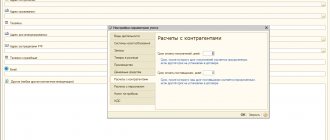What it is
All information on completed transactions flows into the accounting department of the enterprise. It is collected, recorded, filed, and statements and journals are formed on its basis. Accounting registers are special forms containing information from primary documentation; on their basis, financial statements of the enterprise are compiled. They must comply with the requirements of Federal Law No. 402-FZ of December 6, 2011 and be specified in the accounting policies of the organization. According to paragraph 6 of Art. 10 of this law, they can be maintained not only on paper, but also electronically using special programs and websites. They must be certified by the digital signature of the head or chief accountant of the company.
List of approved registers
For your information! At the moment, a draft FSBU law No. 83n dated April 18, 2018 is being prepared, which will come into force in 2020 and will apply new rules regarding primary records and registers.
https://youtu.be/SiHs90F9jMc
Accounting registers: list
Information from the Ministry of Finance dated December 4, 2012 No. PZ-10/2012 states that unified forms of accounting registers are no longer mandatory for use, except for those established by authorized bodies. Now, when creating accounting registers at enterprises, it is only necessary to comply with the presence of mandatory details in them (clause 4 of article 10 of the law dated December 6, 2011 No. 402-FZ).
In addition, according to paragraph 5 of Art. 10 of Law No. 402-FZ, register forms provided by the chief accountant must be approved by the head of the organization. The list of used accounting and tax accounting registers must be given in the company's accounting policy.
You can learn about tax accounting registers from the article “Tax accounting registers for VAT: fixing them in accounting policies.”
At the same time, the forms of accounting registers of state-owned enterprises are established in accordance with the current budget laws. The list of such registers was approved by Order of the Ministry of Finance dated March 30, 2015 No. 52n.
In practice, quite often commercial enterprises, when developing their own registers, take as a basis the list and forms of registers intended for state-owned enterprises.
Here is an excerpt from this list in the form of registers often used in practice:
Inventory cards:
|
Gazette:
|
Books:
|
Magazines:
|
Registries:
|
Cards:
|
Inventory:
|
Gazette:
|
Responsible person
Registers are part of accounting; all organizations, except individual entrepreneurs and branches of foreign companies, are required to compile them. The chief accountant must provide the head of the company with a list of all necessary information. Based on the approved list, an Order on the use of registers is issued; the information must be reflected in the accounting policies of the enterprise. The order approves the forms for each account:
- turnover balance sheet;
- account card;
- account analysis.
A person responsible for maintaining documents is appointed. According to Instruction No. 33n, all accounting registers are formed within the reporting period. If a company does not meet deadlines, this may indicate poor record keeping and weak management control.
Storage order
Accounting documents must be stored in a specially designated room on shelves or in cabinets. Storage periods are stated in two main legal acts:
- Article 29 “On Accounting” - storage for periods established in accordance with the rules for organizing state archival affairs, but not less than 5 years after the reporting year.
- In paragraphs 8 clause 1 of Article 23 of the Tax Code of the Russian Federation - taxpayers are required to ensure the safety of accounting and tax accounting data and other data necessary for the calculation and payment of taxes, including accounting registers confirming the receipt of income, expenses, and payment (withholding) taxes, unless otherwise provided by the Tax Code of the Russian Federation.
In this case, the period of 4 years established by the Tax Code of the Russian Federation begins after the reporting (tax) period in which the documentation was last used to prepare tax reports, calculate and pay taxes, confirm income received and expenses incurred. In addition, a longer retention period may be established for certain types of registers. For example, payroll records must be kept for 75 years.
Therefore, the organization is obliged to ensure the safety of some registers throughout the entire period of activity, and then transfer them to the archive for storage.
Sample forms of accounting registers - 2020 can be downloaded below.
Turnover balance sheet
Existing types
Accounting registers are:
- order journals;
- statements;
- certificates;
- cards.
Based on the balance sheet, for example, the company's balance sheet is formed. It is customary to classify them according to purpose, type and generalization of information. According to their purpose, they can be divided into:
- Chronological - entries are made in them according to the date of the transaction, as a rule, a monthly period is taken. This could be bank statements, a cash book.
- Systematic - in these accounting registers, records are kept on accounts; a balance sheet or general ledger serves as a model. This also includes cards in which the accountant enters important business information.
- Synchronistic - if the register combines both principles, then it will be classified as complex or synchronistic. An example is the general ledger.
Systematic and chronological types of records complement each other. On their basis, the Mendes rule is implemented, which consists in the fact that the sum of the revolutions of chronological registers is always equal to movements in the debit or credit of systematic registers.
Table of different types
Using an integrated approach frees the accountant from reconciling data on various turnover sheets, because the results for analytical and synthetic accounts in this case will still be identical.
Based on the nature of information summarization, registers can be divided into:
- Analytical – data is entered from one account: accounting for fixed assets, settlements with counterparties, and storage locations. The information must state the content of the fact of the operation, its characteristics and a brief description. An example is an inventory card of fixed assets.
- Synthetic – designed to record summarized data from several homogeneous accounts for similar transactions. An example is the balance sheet.
- Complex – contain both analytical and synthetic principles. An example is order journals.
After a month, the primary documents that serve as the basis for entering information into the accounting registers are compiled in chronological order and provided with a certificate for archival storage.
Types of accounting registers
Accounting registers allow you to systematize and accumulate information received from primary accounting documentation, which will subsequently be used for reflection in accounts and accounting records. Based on data from accounting registers, financial statements of the enterprise are compiled.
By entering data into the accounting registers, the accountant can simultaneously carry out primary registration and monitor the business activities of the enterprise by analyzing the results.
Accounting registers are divided into:
- systematic - they keep records of accounts; example - the general ledger of an enterprise;
- chronological, in which records are kept according to the calendar without any other special systematization, for example, a cash book, registration journals;
- synchronistic - combining the features of maintaining registers inherent in the groups listed above; An example of this type of accounting register would be an order journal.
Accounting registers differ in the form of construction into:
- one- or two-sided;
- checkerboards - in them, as a rule, entries for debit accounts are made horizontally, and for credit accounts - vertically.
Based on the volume of content, accounting registers are divided into types as follows:
- analytical - in such registers the indicators of a certain synthetic account are specified; they are used to monitor the condition and movement of material assets, settlements with counterparties, etc.;
- synthetic - in them, entries are made on the basis of grouped homogeneous documents in monetary terms and in a generalized form; an example would be a general ledger;
- complex - they combine the characteristics of the first two subtypes and are used mainly in the journal-order type of accounting.
By appearance, registers are divided into:
- cards - forms that look like a lined table; cards can be account-accounting, multi-column and inventory, for example, a card for analytical accounting of materials;
- books - printed and bound multi-page registers; pages in books, as a rule, are numbered, laced and signed by the chief accountant, for example, a book on accounting for fixed assets;
- free sheets are a kind of scaled cards, for example, statements;
- machinegrams are registers compiled/printed using computer technology.
Forms of accounting registers
By appearance, registers are divided into:
- Books, the pages of which are necessarily laced, numbered, signed by the chief accountant and sealed with the seal of the organization.
- Cards. These are separate sheets, lined in the form of a table, which must be stitched together. They contain information on the names of accounting units, such as fixed assets, contractors, and goods. They are recorded in a special register.
- Magazines. Similar to books, but contain fewer pages and are not laced.
- Sheets. Individual documents are made in the form of a table or have a free form for text entries.
- Machine registers are only in electronic form, signed with a digital signature of the responsible person and stored on a computer or removable media. If necessary, it should be possible to print them at any time.
Journal
By Order of the Ministry of Finance No. 52n dated March 30, 2015, in accordance with budget laws, a list of registers for state enterprises was approved. They are often used not only by budgetary institutions, but also by commercial companies, including agricultural and construction companies.
Additional Information! All statements, cards and sheets must be filed in separate folders.
Results
The use of accounting registers is a prerequisite for every company. After all, reporting is compiled on their basis. And besides, they are needed to accumulate and systematize all important accounting information.
In commercial enterprises, forms of accounting registers are developed independently (often on the basis of already existing and frequently used once regulated forms) and approved by order of the manager.
For state-owned enterprises, register forms are approved by the Ministry of Finance. You can find more complete information on the topic in ConsultantPlus. Full and free access to the system for 2 days.
Rules of conduct
After Order of the Ministry of Finance No. PZ-10/2012 dated December 4, 2012, enterprises are not required to use unified forms, but can choose and develop their own. Until this point, accounting register data was a trade secret. The necessary details have been preserved, which should contain:
- Document's name.
- Name of company.
- Date of compilation or period of maintenance.
- Systematic or chronological classification of operations.
- In what units of measurement and in what currency are records kept.
- Responsible position.
- Signatures and full names of those responsible.
All this data is directly related to the fixed assets accounting registers.
Form
All information entered must be certified by the signature of the responsible person. If errors are found, they may be corrected. In this case, it is prohibited to use a corrector. It is enough to simply cross out the incorrect number with one line so that it remains readable, and write the correct one on top. The reversal method can also be used. To do this, you need to cross out the entire line and make a new entry with a red ballpoint pen. Corrections are made to electronic accounting registers by the person responsible for maintaining them.
For your information! Ready-made register forms are freely available; they can be found on the Internet, downloaded and printed.
https://youtu.be/zu7PfVqLweM
Details and rules of conduct
Although the legislation does not currently provide for the mandatory use of unified forms by business entities, there is a list of mandatory details that accounting documentation must contain:
- the name of the document itself;
- name of the organization that keeps records;
- document maintenance period;
- the procedure for classifying accounting objects;
- currency and units of measurement;
- FULL NAME. and the position of the person responsible for maintaining.
All information reflected in the documentation must be certified with the signature of the authorized person who made these entries. Unlike primary documents, corrections of identified errors and shortcomings are allowed in accounting registers. To do this, you need to cross out the incorrectly written information with one line, write the correct information above and certify the correction with a signature. In addition, you can use the reversal method, that is, correct the data by making another entry in red ink. It is not recommended to use a corrector or erase errors.
Accounting ledger example
One of the most common registers is the balance sheet. It is not only easy to fill out, but is also necessary for any commercial enterprise to fill out: in fact, it is this statement that reflects the current balance sheet of the enterprise, as well as its total capitalization.
Therefore, the balance sheet can be used as a sample. It looks quite simple: the content is divided into semantic blocks “How much was before accounting,” “During accounting,” and “By the end of the accounting period.” A table is compiled, divided into two subblocks under each column (the “Debit” and “Credit” blocks, the main ones in accounting).
It is not at all difficult for an experienced accountant to fill out such a table, especially in accounting. documentation, balance sheets are practically the simplest type of register. However, it does give a good initial understanding of what a register looks like and why it is needed, as well as how to fill it out.
https://youtu.be/JFIP8ySmeBI
Storage structure in the database
In order to get a general idea of the internal structure of the accounting register, first let’s look at its basic settings in the configurator. Then we will analyze the structure of the tables in the database and its connection with the register settings.
Case Settings
So, we have an accounting register with the following structure:
Let's describe each of the settings:
- Case Settings
- Chart of accounts - an indication of the “Chart of Accounts” metadata object, which is used by the accounting register.
- Correspondence – a flag indicating whether account correspondence is used when creating entries in the register. The accounting register can operate in two modes: With correspondence - in this case, a double entry mechanism is used, when each register entry contains the fields “AccountDt” (debit account) and “AccountCt” (credit account).
- No correspondence - in this case the double entry mechanism will not be used. Each record will use only one dimension to indicate the account - "Account"
- Organization – link to the “Organizations” directory. The accounting attribute is not used, i.e. the dimension will be used for all entries. The “Balance” setting is set, which determines the support for double entry for this measurement and, accordingly, the convergence of the balance for it. In other words, the accounting register in our case is configured in such a way that the balance sheet can be compiled by organization.
- Amount is a balance sheet figure used for all accounts. The subconto accounting attribute “Sum” indicates whether accounting is maintained for this resource for the subcontos specified in the invoice. We’ll talk about this in more detail and look at how this setting works using examples.
- Contents —attribute with the “String” type (max. length 150) for storing reference information of register entries.
As we can see, filling in the fields of the accounting register is mainly influenced by accounting accounts. Depending on the characteristics of account and subconto accounting, it is determined which dimensions and resources are used for recording, how the totals for accounts and subcontos should be stored, as well as other settings.
For beginners, all these settings seem confusing.
We will not go into detail about the purpose of each of the register and chart of accounts settings. You can learn about each setting from an application point of view on ITS and here . Also, in subsequent articles, we will dwell in more detail on each setting and analyze its impact on the structure of register tables and how the 1C:Enterprise platform works with them.
Register tables
In our example, we use an accounting register with correspondence support and with a maximum number of subcontos - 3. For measurements, both invoice accounting characteristics and subconto accounting characteristics are used. As a result, the platform created the following table structure:
1. Main table (_AccRg[internal number]) - the main table of the register, which stores data similar to the register structure that is specified in the configurator (dimensions + resources + details). In our example it looks like this:
Note that the values of additional Analytics, namely subcontos, are not stored in the main register table. To store them, a separate table is used, which contains all register fields, including standard ones (period, registrar, record number). There is also a Boolean “Activity” field, which affects whether the record will affect the total tables (if True, then the record is taken into account in the total tables).
2. Subconto values (_AccRgED[internal number]) - the table is created if subcontos are used for the chart of accounts of the accounting register. It is needed to store the values of subconto records of the main register table. In our example, the table has the following structure:
The “Movement type” field can contain two values: 0 - debit, 1 - credit. The subconto view in most cases contains a link to the characteristic type plan element that specifies the subconto types. The subconto value is stored according to rules similar to the data type that needs to be stored. In our case, this is a reference type (you can read more about the values of each field in this case in one of the previous articles ).
3. Summary tables. The accumulation register totals tables include:
Balance table (or account totals table) (_AccRgAT[internal number])
From the name it is already clear that the table stores the totals of account balances, by periods and in terms of dimensions of the accounting register.
For each resource, the debit and credit turnover, as well as the total turnover, are stored. When using total division for a register, the service field "Separator" is used to increase the parallelism of user work. The principle of operation of dividing totals is similar to its use in accumulation registers, so we will not go into more detail. Turnover table (or table of totals between accounts) (_AccRgCT[internal number])
The turnover table stores turnover between accounts in the context of balance sheet dimensions of the register.
As in the table of balances, debit and credit turnovers for register resources are stored and there are service fields for the mechanism for dividing totals. Subconto total tables (or totals for accounts with subconto) (_AccRgAT[number of subcontos][internal number])
Subconto totals tables store subconto totals for accounts in the context of accounting register dimensions. The tables store turnover by register resources (by debit and credit). The tables also contain fields for the total splitting mechanism.
The main feature of storing subconto totals is the use of several tables for these purposes. In our example, the chart of accounts, which is used by the accounting register, has a maximum number of subaccounts - 3. In this case, the platform creates three totals tables, where it stores the totals for 1 subaccount, 2 subaccounts and 3 subaccounts.
In subsequent articles, we will analyze in more detail how the platform works with totals and use an example to analyze changes in data in tables. The issue of the influence of the number of subcontos on the performance of accounting registers will also be considered.
4. Settings for storing totals (_AccRgOpt[internal number]) - tables with settings for totals of the accounting register. They have the following structure:
The table of settings for storing totals stores data by which the platform determines exactly how totals will be calculated for a given register, whether to use current totals and other settings. We'll talk about them in more detail later.
Note: a similar table is available for accumulation registers. When we looked at this topic earlier (back on the 8.2 platform), settings such as max. and min. There were no totals for the stored period. This is an innovation of platform 8.3. Using the accounting register as an example, we will analyze the operation of these settings, which will also be relevant for accumulation registers.
Thus, we have reviewed general information about the structure of the accounting register tables. In some respects, its internal structure is similar to the accumulation register, with the exception of tables of additional analytics - subconto, as well as tables of totals for them.










